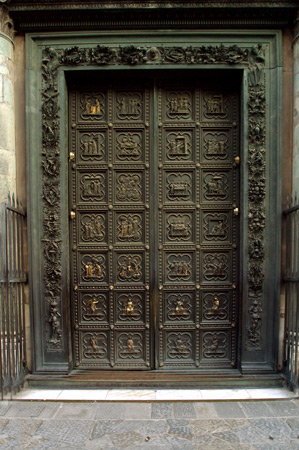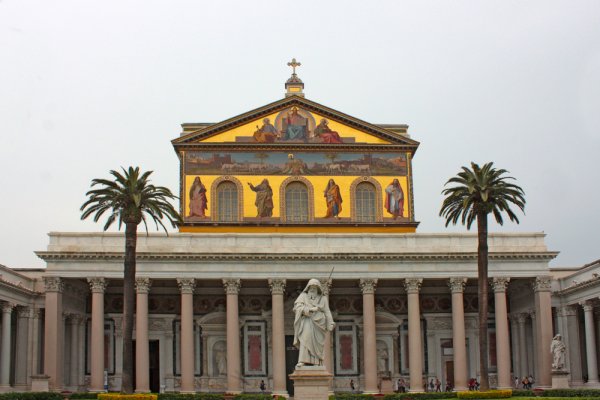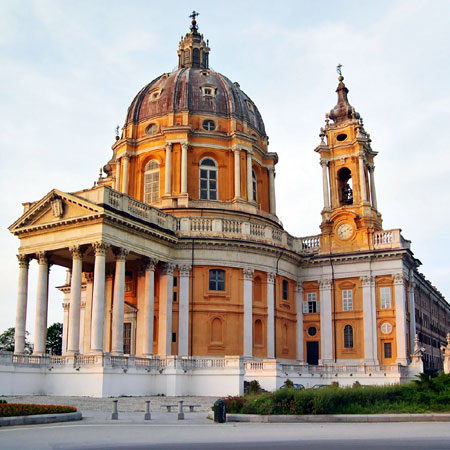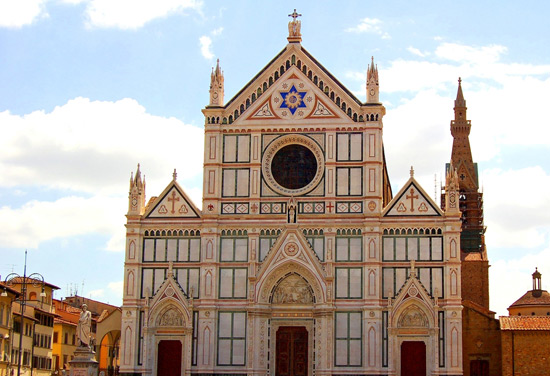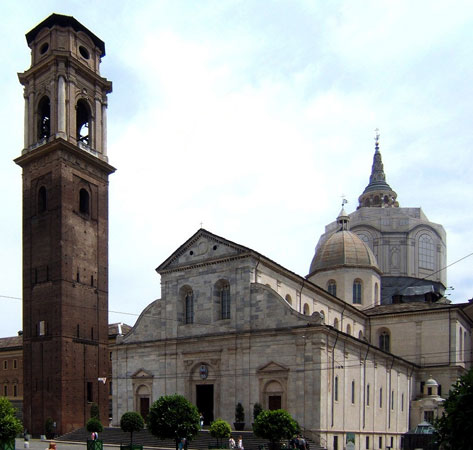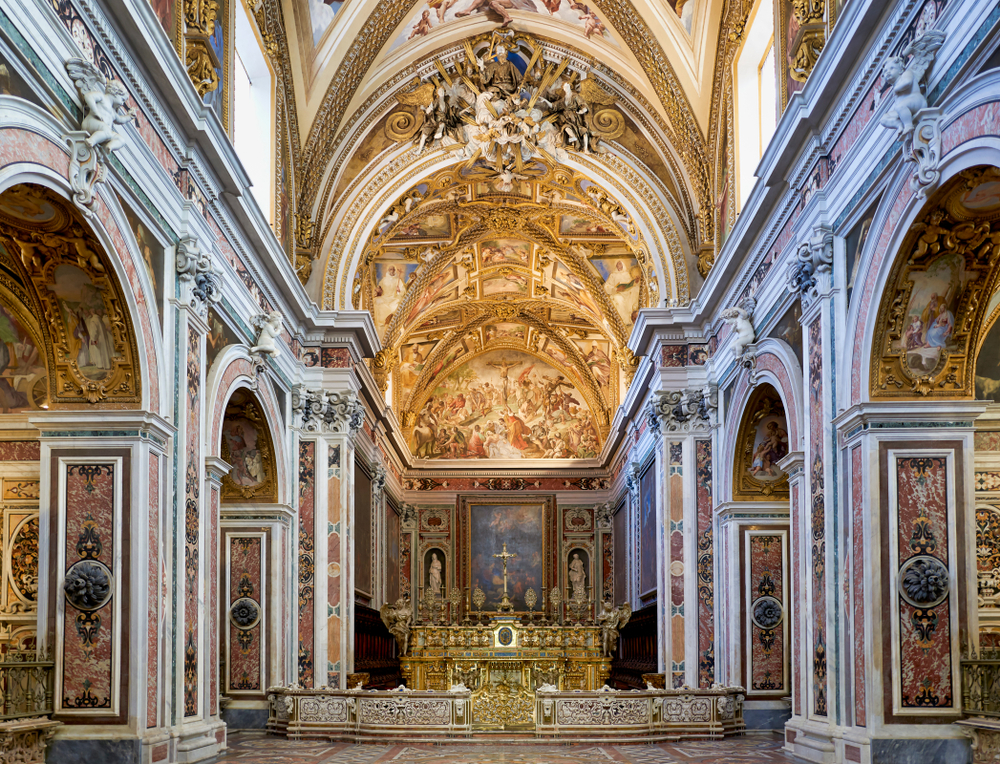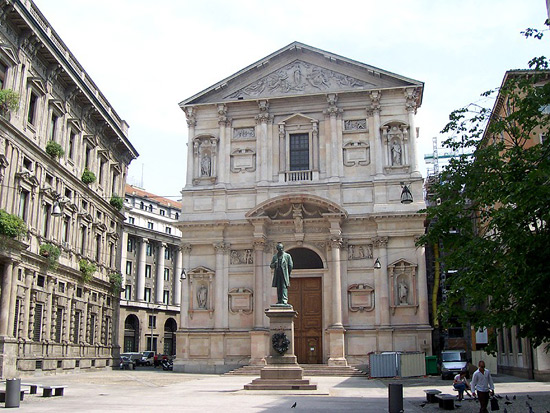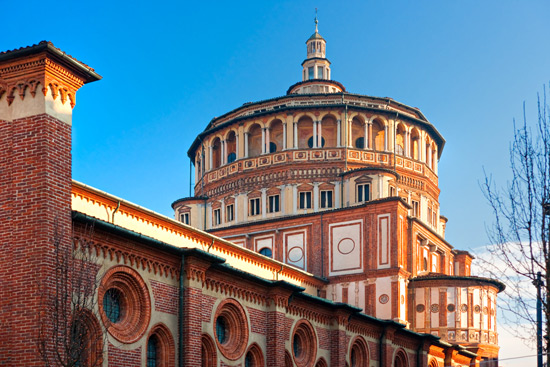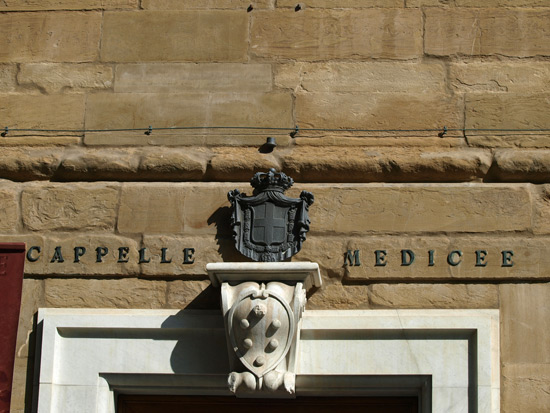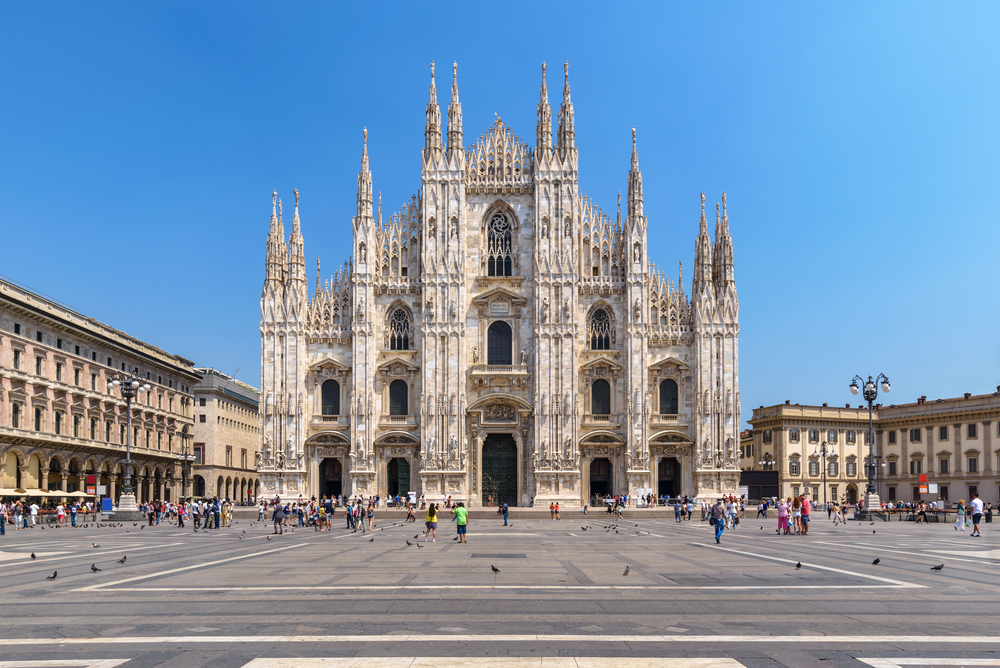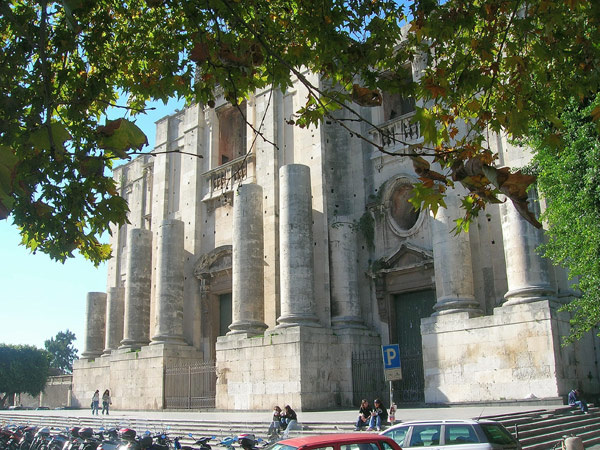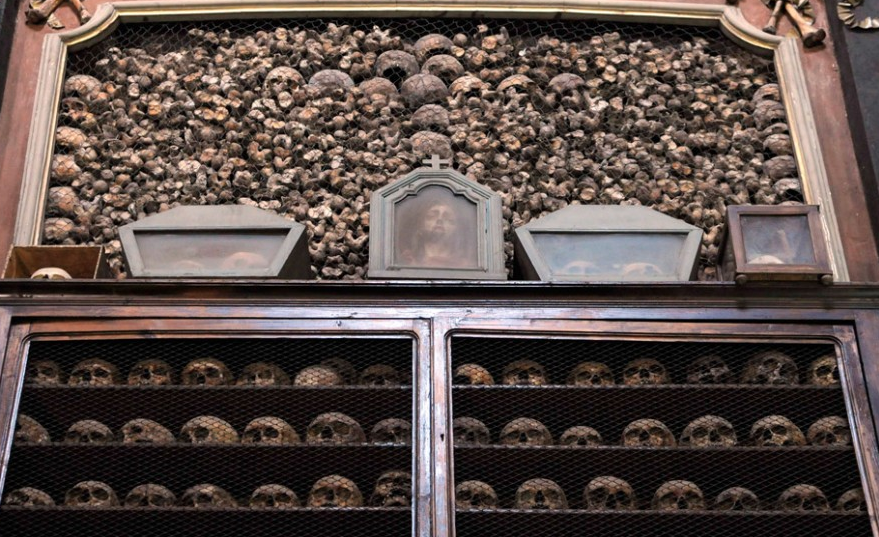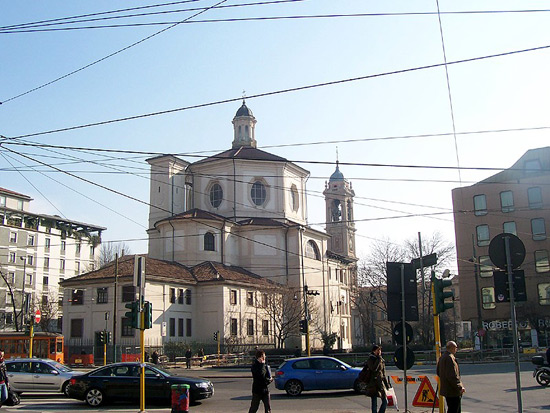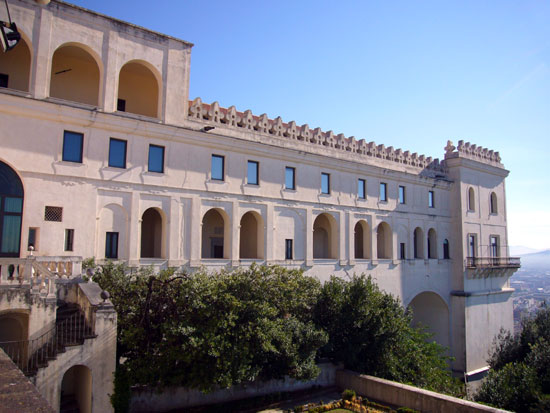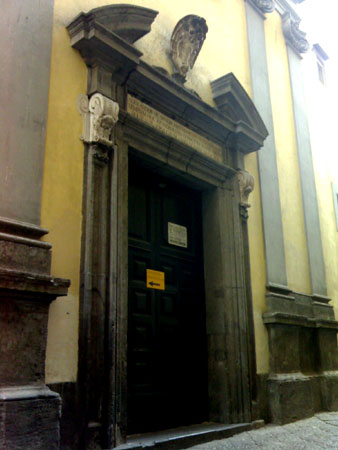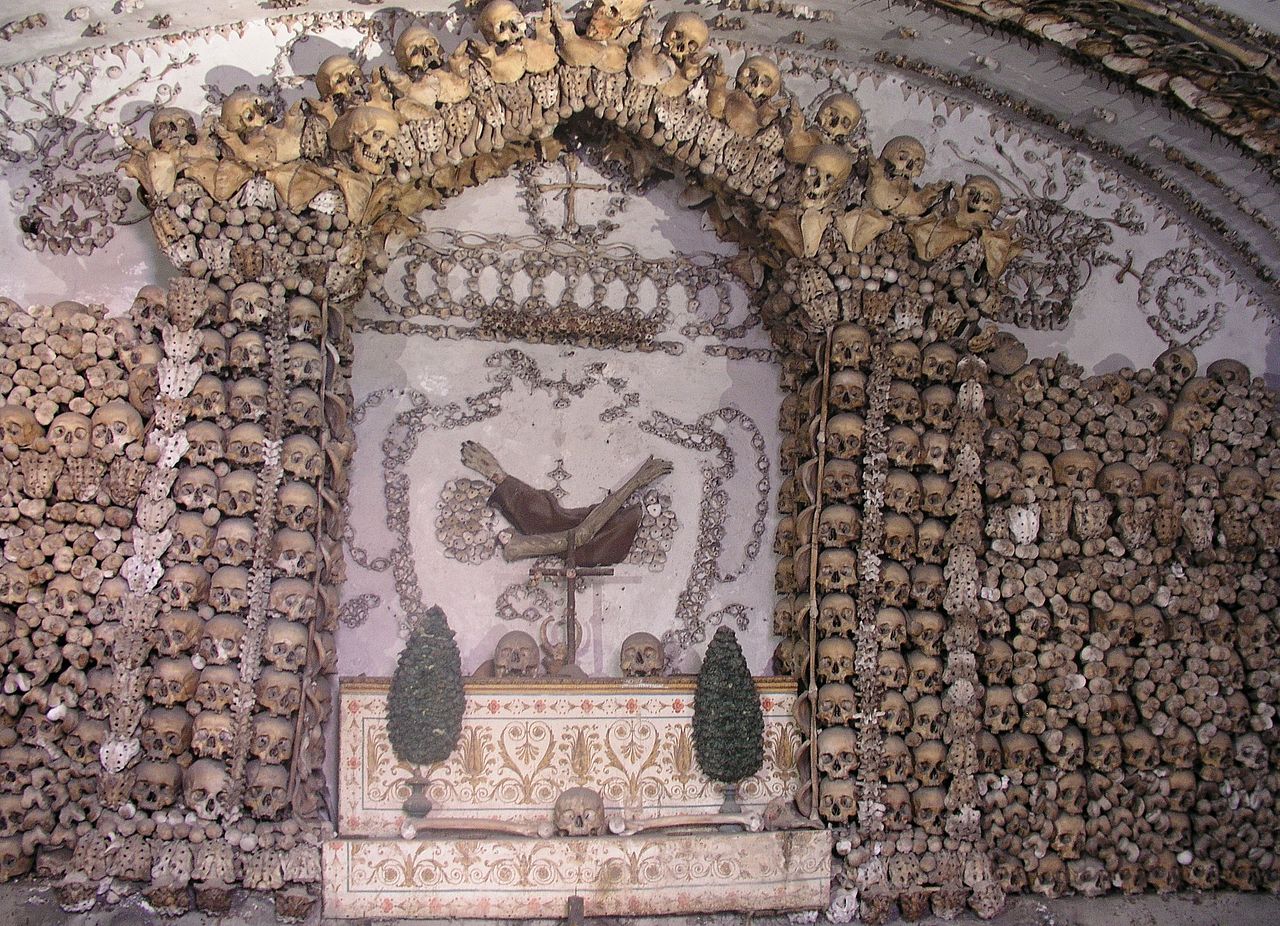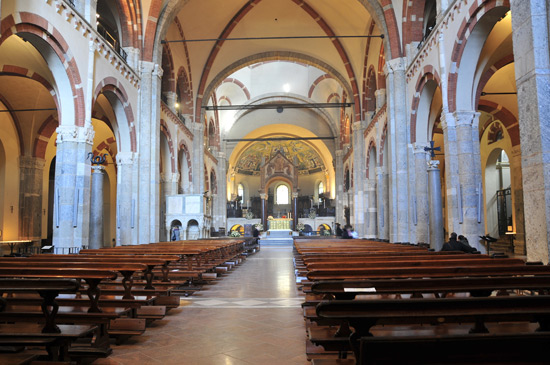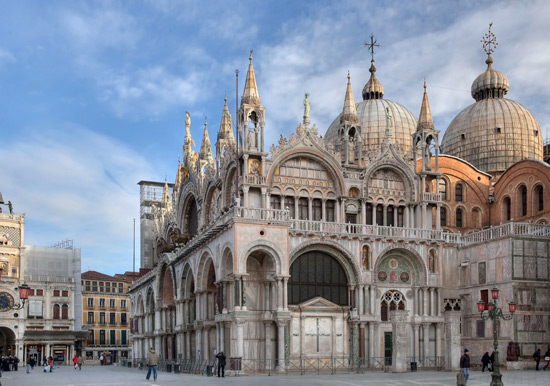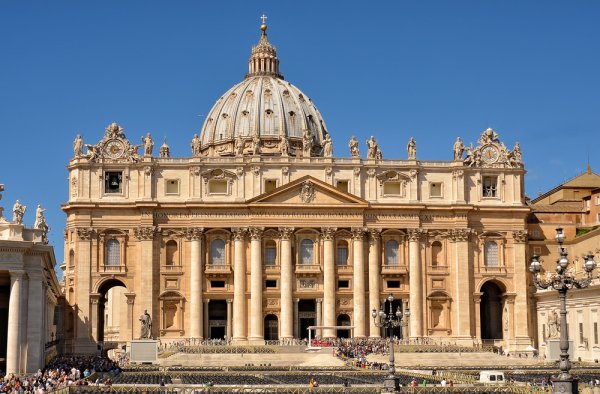Points of Interest
Baptistery of St. John
Battistero di San Giovanni Piazza San Giovanni
Florence, Italy
Standing on the site of what was probably a Roman palace, the Baptistery was fashioned into its current eight-sided form in the 11th century. The Baptistery is ringed inside with ancient Roman columns, and both the floor and the ceiling are covered with intricate mosaic designs. Don't miss the doors to the Baptistery, specifically the north and east pair designed by Lorenzo Ghiberti. He was 22 when he won a contest to design the north doors in 1401. Today, many art historians focus on that date as the beginning of the Renaissance. Ghiberti spent the next 21 years creating the doors, and the result was so stunningly impressive that he was asked to do the east doors as well. He finished some 27 years later, just prior to his death, Years later Michelangelo declared the doors' beauty made them fit to be the Gates of Paradise, which is how they've been know ever since.
Basilica of San Clemente
Basilica di San Clemente al Laterano 95 Via Labicana
Rome 00184, Italy
The San Clemente Basilica was founded in a private home, sometime in the 4th century CE. This was a time of persecution for Christians, who were forced to practice their faith in secret. The present building was constructed in the 12th century, although the portico and several other features were added as late as the 19th century. The church features some outstanding mosaics, but most come to see the excavated remains of the earlier churches (and a pagan temple) that lay beneath. Through an entrance in the sacristy, visitors descend into the 4th-century basilica, built where the private home stood. On the lowest and oldest level is a 1st-century temple to the Roman god Mithras.
Basilica of St. Francis
Basilica di San Francesco 2 Piazza San Francesco Assisi
06081 Perugia, Italy
Construction for the Basilica of St. Francis began in 1228 by Brother Elia, a disciple of St. Francis. The beauty and splendor of this medieval masterpiece, which combines a high level of art and deep spirituality, ensure an emotional experience for art lovers and devout pilgrims alike. The crypt contains the venerated stone coffin of St. Francis surrounded by the graves of four disciples. Among the relics of St. Francis on exhibit here are a patchwork tunic, shirts, slippers, a letter signed by the saint, the rock used to rest his head in the coffin, and a few other belongings. The basilica also contains masterpieces by artists like Cimabue, Pietro Lorenzetti, Simone Martini, and Giotto.
Basilica of St. Mary of Health
Basilica di Santa Maria della Salute Fondamenta Salute, Italy
With its marshy air and close-packed houses, Venice in the Middle Ages was especially vulnerable to the plague. In 1630, after losing more than 45,000 residents, the city commissioned Baldessare Longhena to build a church to thank the Virgin Mary for saving Venice. Longhena, a pupil of Palladio, was a relatively young man when construction began in 1631. The project would outlast him and take more than half a century to complete. His church, known commonly as La Salute, is octagonal and made of stone quarried from Istria. The sacristy includes a little art gallery featuring works by Titian and Tintoretto. In the 17th century, the Senate would visit La Salute annually to offer thanks to the Virgin, and Venetians still come here on November 21 each year to give thanks for another year of health.
Basilica of St. Paul
Basilica Papale San Paolo fuori le Mura 1 Piazzale San Paolo
00146 Rome, Italy
This basilica, founded by Emperor Constantine I, stands over the burial place of St. Paul, where his followers had previously erected a cella memoriae (memorial). The structure, with a length of 131.7 meters (432 feet), width of 65 m (213 ft), and height of 29.7 m (97.5 ft), is one of the four great ancient churches in Rome. Over the years, the basilica underwent frequent repairs and extensions, and, under Gregory the Great (590–604), was further modified to place the altar directly over the tomb of St. Paul. In 1823, when a fire almost completely destroyed the basilica, many countries contributed to restoring it back to its ancient glory.
Basilica of Superga
Basilica di Superga Strada della Basilica di Superga 73
Turin, Italy
In 1706, Victor Amadeus II climbed this hill to look down upon the massive French army besieging Turin. If the city survived, he pledged, he would build a magnificent church dedicated to the Madonna. After Piedmont was saved by a Holy Roman Imperial army, the Savoy prince made good on his vow, commissioning this sumptuous hillside edifice. The architect was Filippo Juvarra, a Sicilian stage set designer whose particular brand of baroque architecture became fleetingly fashionable across western Europe. Along with containing the graves of more than 50 Savoy royals, the Superga hill also marks the spot of a 20th-century tragedy, when the airplane carrying the Torino soccer team crashed into it on a foggy day in 1949. The team was just four matches away from winning the championship and, as a mark of respect, the other Italian teams fielded youth players in the remaining matches against Torino.
Basilica of the Holy Cross
Basilica di Santa Croce Piazza di Santa Croce Across from Via dei Benci
Florence, Italy
At the top is Michelangelo, who lived to be 89, before succumbing to a fever in 1564. Near his tomb is a cenotaph for the poet Dante, whose bones are actually in Ravenna, where he died in 1321 after living in exile from his hometown for the last portion of his life. Also here is Galileo's tomb, which has a relief of the solar system with the sun in the middle, depicting the then-heretical heliocentric view of the galaxy for which the Roman Inquisition convicted him. Others entombed in this church are composer Gioachino Antonio Rossini, philosopher/writer Machiavelli, and radiotelegraph inventor Guglielmo Marconi.
Capuchin Crypt
Cripta Cappuccini Santa Maria della Concezione dei Cappuccini Via Veneto 27
Rome 00187, Italy
Rome is crisscrossed with catacombs—underground ossuaries, filled with centuries worth of human bones. Some of these remains were once priests or parishioners, some were paupers, and others were removed from cemetery grounds given over to development. Of all the catacombs, perhaps none are as macabre as those beneath Santa Maria della Concezione. The church was completed in 1631, and administered by the Capuchin Friars, a Franciscan order that took vows of poverty and begged barefooted for their meals. It's a relatively small and undistinguished church; most visitors come for the catacombs beneath. Here, the bones of more than 3,500 people have been arranged into the shape of crosses and other religious symbols, used to decorate numerous underground chapels. There are chapel archways and altars made entirely of human skulls, and skeletons dressed in monks' robes for statues. It is a strange, eerie place, needless to say.
Cathedral of Santa Maria del Fiore
Duomo 1 Via della Canonica
50122 Florence, Italy
Too famous and majestic to miss, the construction of the Cathedral of Santa Maria del Fiore began in 1296. Designed in Gothic style, this is the third-largest church in the world, after Rome’s St. Peter’s Basilica and London’s St. Paul’s Cathedral. The nickname of Duomo derives from the enormous octagonal dome on the east end, while the structure itself is 153 meters (502 feet) long, 90 m (295 ft) wide at the crossing, and 90 m (295 ft) tall. Visitors will enjoy learning interesting facts, like how the dome remains the largest brick and masonry dome ever built and how skeptics thought it would collapse.
Today, the Duomo is recognized around the world as a symbol of both Florence and the Renaissance. There are ceiling and wall frescoes, detailed mosaics, and stained-glass windows by artists such as Vasari, Zuccari, Donatello, and Ghiberti. Also inside is the New Sacristy, where early Italian Renaissance statesman Lorenzo de' Medici took shelter in 1478 after he and his brother Giuliano were attacked (Giuliano was killed) while attending Mass. The views from atop the cupola are incredible, reached only after climbing 463 winding steps, which may be too much for little kids but prove a good challenge to older ones.
Cathedral of St. John the Baptist
Duomo di San Giovanni Battista Via XX Settembre 87 Piazza San Giovanni
Turin, Italy
It has been Turin's most celebrated icon for centuries: Sacra Sindone (the Holy Shroud), an enigma in linen. Thought to be the cloth that wrapped the crucified body of Christ, this length of linen has been debated and discussed virulently for hundreds of years. Even after the Catholic Church agreed to sophisticated carbon dating in the 1990s, the genesis of the shroud was not completely clear. Due to the relic's age, it is only shown every quarter of a century, though there is a permanent replica on display in front of the altar of this 15th-century cathedral (plus a museum, the Museo della Sindone, on nearby Via San Domenico). Outside this Renaissance structure designed by Meo del Caprina, look out for Turin's Roman remains, the old Porta Palatina gate, flanked by two towers.
Charterhouse of St. Martin
Certosa e Museo di San Martino 5 Largo San Martino
80129 Naples, Italy
There is much to see and admire at this former monastery, from its museum full of artifacts and the hanging gardens, to the view from its Vomero hilltop setting. Take the funicular at Montesanto station to get here then wander the grounds and admire the chapel’s intricate exterior. Inside are the painted ceilings and marble alters that amount to what some say is the most beautiful church in the city. Kids will see boats, model ships, swords, pistols, and much more in the museum. Adults will appreciate the 17th-century paintings and collection of presepi (nativity scenes). The views from outside offer all of Naples below, including Mount Vesuvius and the Gulf of Naples. Once you’ve taken your share of outstanding photos, wander the Vomero neighborhood and shop, grab a bite to eat, and finish off with some gelato.
Church of Saint Minias on the Mountain
Via delle Porte Sante
Florence, Italy
Construction began in the early 11th century and is a particularly striking example of Florentine Romanesque architecture, with a façade of inlaid green and white marble in geometrical designs. Among the wonders inside is the Cappela del Cardinale del Portogallo (Chapel of the Cardinal of Portugal), which was built to honor Cardinal Jacopo di Lusitania, known for his devotion to the church and humanist philosophy. Be sure to take a long look at its glazed terra-cotta dome, created by Luca dell Robbia, which depicts the four Virtues surrounding the Holy Spirit.
Church of San Fedele
Chiesa di San Fedele Via Ulrico Hoepli 3
Milan, Italy
Unlike the sometimes extravagant elegance of its Renaissance counterparts, San Fedele is a Jesuit church designed in austere fashion and enlivened only by the odd baroque touch. This tribute to Fidelis, the patron saint of the Como diocese, was the brainchild of uber-architect Pellegrino Tibaldi, who impressed Cardinal Borromeo with his ability to interpret the subtle aesthetic themes of the Counter-Reformation. The interior's column-supported single nave contains mannerist paintings by the likes of Peterzano, Crespi, Figino, and Fontana; baroque confessionals; and carved choir chairs transported here from the Santa Maria della Scala before its conversion into the opera house.
Church of San Giorgio Maggiore
Chiesa di San Giorgio Maggiore Isola San Giorgio Maggiore
Venice, Italy
The view of this striking white island church from St. Mark's Square is delightful, but it's not half as pretty as the corresponding outlook from the bell tower of San Giorgio Maggiore itself. Take a vaporetto out to the island for one of Venice's most charming churches. (Claude Monet was an admirer, and painted an oil canvas of it.) Andrea Palladio was commissioned to design it, and he began construction in 1566. The church is a beautiful example of Palladio's strict architectural principles, reflecting the mathematical harmonies of the great Renaissance architect. San Giorgio Maggiore may be relatively spartan inside, but it does contain a handful of top-class paintings, including two works by Tintoretto (The Last Supper and Fall of Manna), as well as works by Sebastiano Ricci and Jacopo Bassano. Finish your visit by taking the elevator up the bell tower.
Church of St. Agatha of the Prison
Via Colosseo
Sicily, Catania, Italy
This Old Town church dates back to the 12th century, although the classical front is an 18th-century addition, courtesy of the great earthquake of 1693. It was built, legends say, on the location of the prison cell occupied by the saint herself. Agatha was a well-born Sicilian lady who refused the advances of a Roman officer. Enraged, he demanded that she pay tribute to Rome's gods and, when she refused, he tortured her by cutting off her breasts. Today, Agatha is remembered as the patron saint not only of Catania, but also of women with breast cancer, bakers, and bell-founders. If the church is open, it may be possible for visitors to ask the custodian if they can see the claustrophobic cell where Agatha was incarcerated before her death. Look out too for the medieval gate (reputedly that of the cathedral), the animal sculptures atop the columns, as well as two volcanic rock slabs, which show the saint's tiny footprints.
Frari Basilica
Basilica dei Frari San Polo 3072
Venice, Italy
This grand red brick church (known fully as the Basilica di Santa Maria Gloriosa dei Frari) appears rather austere from the outside, as many Franciscan churches do. Inside, though, is another story. Here are some of the city's greatest works, as well as the resting places of several of its most celebrated citizens. Titian's Assumption is displayed above the church's altar. Note the richness of the reds, which would make both the painter and the painting famous. Titian was also responsible for the Pesaro Madonna, which was reputedly modeled on his wife. The Veneto-born painter is buried here, alongside no fewer than four doges and the composer Claudio Monteverdi. Also interred in Santa Maria Gloriosa dei Frari is the heart of Antonio Canova, held in a strangely large marble pyramid, which the sculptor originally intended as a mausoleum for Titian.
Holy Mary of Grace Church
Santa Maria delle Grazie Piazza Santa Maria delle Grazie 2
Milan, Italy
The gorgeous, Bramante-designed luminous tribune of this church is almost as impressive as the masterpiece contained in its former refectory, Leonardo da Vinci's fresco The Last Supper, depicting the moment when Jesus learns of his betrayal. The figure of Judas is positioned to the right, his hand over a bag of silver. Miraculously, the painting survived the bombing of the refectory's roof in World War II. More recently it was the subject of a controversy concerning corrective overpainting (and figured heavily in a work of popular fiction bearing Leonardo's toponym in the title). Scaffolding permanently blocks the view of the lower part of The Last Supper, but the rest is easily visible. Reservations for visits are essential and you should arrive a quarter of an hour before the scheduled start time.
Medici Chapel
Cappelle Medicee Piazza di Madonna degli Aldobrandini Basilica of San Lorenzo
Florence, Italy
The Sagrestia Nuova (New Sacristy) holds two tombs for Medici family members, but not that of Lorenzo de' Medici the Magnificent, for whom the Chapel was designed. Michelangelo simply never finished Lorenzo's tomb, but the space does have three of his most striking sculptures—Aurora e Crepusculo (Dawn and Dusk), Notte e Giorno (Night and Day) and Madonna col Bambino (Mother and Child). The second structure is the Cappela dei Principi (Princes' Chapel), a 17th-century monument to excessive opulence that contains tombs of the Medici grand dukes.
Medici-Riccardi Palace
Palazzo Medici-Riccardi Via de Ginori
Florence, Italy
The Cappella dei Magi (Chapel of the Magi) was the Medici private chapel and is the oldest to survive from a Florentine palazzo. Detailed frescoes by Benozzo Gozzoli depicting the journey of the Three Wise Men cover the Chapel's walls; figures in the frescoes have faces of famous figures of that time, including members of the Medici family, the Patriarch of the Eastern Orthodox Church, and the Byzantine Emperor, the latter of whom had been in Florence for the Council of 1439.
Milan Cathedral
Duomo di Milano Piazza del Duomo
20122 Milan, Italy
Whether you simply tell the kids, “They don’t make ‘em like that anymore,” or that the construction of the Milan Cathedral began in 1386 and took nearly 600 years to complete, this beautiful sight should impress the whole family. The cathedral, called the Duomo, played a significant role in spreading the Christian faith and establishing Catholic traditions of worship. Measuring 157 meters (515 feet) long, 92 m (302 ft) wide, and more than 106 m (350 ft) high, the 40,000-seat capacity Milan Cathedral is the second-largest church in Italy (next to St. Peter's Basilica) and the second-largest Gothic cathedral in the world (after the Cathedral of Seville in Spain). The cathedral's numerous monuments and artworks include three superb altars, the St. Bartholomew statue by Marco D'Agrate, the tombs and sarcophagi of many archbishops, and other architectural masterpieces. Guided tours are available, and rooftop views of Milan are worth the small fee.
Modena Cathedral
Duomo di Modena Corso Duomo Modena
41121 Emilia-Romagna, Italy
Work on the Modena Cathedral started in 1099 over the tomb of St. Geminianus, the patron saint of Modena, whose remains are still on display in the cathedral's crypt. The majestic facade of the cathedral includes portraits of prophets and patriarchs, as well as Romanesque sculptures depicting biblical stories like the creation of Adam and Eve, the Fall of Man, and the story of Noah. The splendid interior of the cathedral portrays the Passion of Christ and the Last Supper in marble. The pulpit is adorned with terracotta statuettes and a wooden crucifix that dates back to the 14th century. This structure, with its soaring towers and piazza, is an outstanding example of Romanesque architecture.
Monumental Complex of St. Clare
Complesso Monumentale di Santa Chiara Via S. Chiara 49
Naples 80134, Italy
Standing tall, stark, and intimidating, this Gothic building dates back to 1310 and is one of the city's oldest and most revered religious symbols. During the baroque revolution in the early 1700s, the building got a robust makeover, and its cloister (Chiostre della Clarisse) was furnished with the now-signature Neapolitan blue, green, and yellow majolica tiles that reflect the landscape of sky, grass, and lemon tree. Sadly, Allied forces hit the church and cloister during World War II, resulting in a major loss of the original Gothic features. However, since its restoration over the last century, the basilica and cloister have been restored to their former glory, and the complex houses museum rooms dedicated to the structure's long history, the site's archaeological findings, nativity scenes (presepi), marble, ruins, and reliquaries.
Naples Cathedral
Duomo di Napoli 149 Via Duomo
Naples, Campania. Italy
With a façade similar to the Notre Dame de Paris, the Duomo is Naples' and southern Italy's mother church and the seat of the archbishop of Naples. It is also known as the Cathedral of St. Januarius, Naples' patron saint, whose remains were transferred here from the Catacombs of St. Januarius. Three times a year a vial of St. Januarius' dried blood is brought out to the public, at which point it miraculously liquefies. Like many things religious in Naples, the Duomo was built in the 13th century and later adorned with baroque inspiration. But the church site dates back farther, to the 4th century, when the Basilica de Santa Restituta was built. Of the various chapels incorporated into the whole of the cathedral is the Cappella di San Gennaro, which, with its lavish baroque design, is considered one of the finest examples of Neapolitan Baroque. Be sure not to miss the 13th-century reliefs, 14th-century mosaics, and the Baptistery di San Giovanni, which, dating back to the 4th century, is the oldest baptistery in the West.
Neapolitan Crypt
Cripto Napolitana Piedigrotta
Naples, Italy
Few historical characters have been given as many posthumous attributions as Virgil. This classic poet of the Aeneid, who died in 19 BCE, is supposedly buried in the ancient grotto (a tunnel, actually) designed to connect Naples to Pozzuoli. Lore has it that Virgil conjured the legendary tunnel into being through his powers of sorcery (the same powers that got an egg to hold up the Castel dell'Ovo for two millennia and counting). Whether or not Virgil is interred here, another influential poet is: Italy's beloved Giacomo Leopardi (died 1837); and the park and tunnel are lovely to behold.
Saint Nicolas Arena Church
Piazza Dante
Sicily, Catania, Italy
The monastery complex of Saint Nicolas is named for the sandy soil that permeates this part of Catania. Construction started in 1687 under the guidance of architect Giovanni Battista Contini, but the earthquake of 1693 wrecked the site, and it took another 20 years before building began again. Francesco Battaglia took up the reins of the project in the 1730s, and the complex started to take shape, but the city ran out of money, which explains the eight columns that reach up to an imaginary pediment, which was never added. Saint Nicolas' frontage may look like a broken comb, but what it lacks in finish, it makes up in sheer scale. Visitors who come on a Thursday or a Sunday still marvel at the length of the 105-meter (340-foot) nave, the 62-meter-high (205-foot-high) dome, and the size of the adjacent convent, the second largest in Europe. Today, the complex is part of Catania University. Admission is free.
San Bernardino alle Ossa
Via Brolo
Milan, italy
It may prove difficult not to ponder Milan’s history when faced with the skulls and bones kept within the San Bernardino alle Ossa. The church includes an ossuary, a room where the bones of dead people reside. The bones are not kept hidden away in a box but are on full display, arranged in patterns and rows and fronting whole sections of wall as well as doors and pillars. It is believed that most of the bones came from a nearby hospital and its graveyard designated for deceased patients, though space ran out and a small chamber was built in 1210 to house the bones. When the San Bernardino alle Ossa was built in 1269, the bones were moved into a room near the church’s entrance, which also became the final resting place for bones from other graveyards. If you’re not one to be creeped out by rows of skulls and stacks of human bones, then plan a visit to San Bernardino alle Ossa. The centerpiece is a huge cross made of skulls.
San Bernardino alle Ossa Church
Chiesa di San Bernardino alle Ossa 2 Via Verziere
Milan, Lombardia 20122, Italy
The ossuary walls of this pre-medieval church unsettle some visitors with their decoration of human skulls and tibiae in the shapes of angels and crucifixes. The intention was not to be macabre, however, such an aesthetic tradition is also common in Iberia, and is regarded as a tribute to the dead. The bone theme began as early as 1210 when an extra room was built in the church to display bones taken from the cemetery next door. Much of San Bernardino alle Ossa was destroyed by a fire in 1712 and rebuilt with baroque features that so impressed King John V of Portugal that he had his architects copy the design for a church in Evora, near Lisbon.
San Lorenzo Maggiore Church
316 Via Tribunali
Naples, Italy
The 6th-century San Lorenzo Maggiore basilica was reconstructed in the 13th century, and while its façade hints of (yet another) baroque basilica, the interior tells a Gothic tale of airy simplicity and stunning frescoes and artwork. Not only is this one of Naples' more intriguingly beautiful churches, it contains literary significance as well: 14th-century author Giovanni Boccaccio met his Fiametta here, and Petrarch occupied the convent for some time. All the more thrilling is Il Criptoportico, the crypts beneath the building that lead into excavations of Naples' sottosuolo, revealing the stony remains of the ancient Roman forum. This is one of the city's best underground sites, so be sure to book a tour. The church also houses a museum dedicated to the archaeological, historical, and religious artifacts associated with the site.
San Martin's Charterhouse
Certosa di San Martino 8 Largo San Martino
Naples, Italy
Perched high on the hill of Sant'Elmo in the foreground of the Sant'Elmo Fortress, this monastery-turned-museum was built in 1325 and restored in the 1600s. The imposing structure contains world-class paintings, sculptures, and frescoes by acclaimed medieval and Renaissance artists. Baroque and rococo style dominate the church, complete with marble floors and lapis lazuli, signs of the Catholic Church's new and opulent leanings in a time of change for Christian life. After exploring the church, visit the museum, which contains centuries of Italian artifacts, drawings, sculptures, and one of the finest nativity scene collections (presepi) in the world.
Sansevero Chapel Museum
Museo Cappella Sansevero 19/21 Via Francesco de Sanctis
Naples, Italy
Naples has a stake in the dark and occult, and this chapel-turned-museum speaks to this eerie current running through the city's sites. In the early 18th century, eccentric Renaissance man Prince Raimondo di Sangro of Sansevero more or less repurposed the chapel into a celebration of death. The most notable aspect of his contribution is the presence of several sculptures depicting veiled people: veiled naked women, a man disentangling himself from a net, and a veiled Christ, whose stony sheath lays over his realistic body like milky glue. Curiosity-shop types will get a thrill out of the underground chamber, where 18th-century "anatomical machines" contain the bodies of a man and a woman whose skeletons and, unbelievably, circulatory systems, remain intact and on display. Legends tell the rest of the story, which would make for a fascinating thriller if Hollywood would just pick it up. The prince's tomb is here too, as if that comes as a surprise.
Santa Maria della Concezione
27 Via Vittorio Veneto
Rome 00187, Italy
The crypts beneath Rome’s Santa Maria della Concezione dei Cappuccini are the final resting place of more than 4,000 Capuchin friars who died between 1528 and 1870. Known as Capuchin friars because of the capuche meaning “hood” attached to their brown tunic, they moved from the friary of St. Bonaventure in 1631 bringing with them the remains of deceased friars so that all the Capuchin friars could be in one place. The bones were sorted by type with all the skulls, leg bones, and pelvises were used to decorate different crypts along with a plaque that reads, “What you are now, we once were; what we are now, you shall be.” Mummified monks dressed in friar clothes hang from the walls and ceiling. Today, the church also includes a museum.
St. Agatha's Cathedral
Via Etnea 28
Sicily, Catania, Italy
Sicilian architect Giovanni Battista Vaccarini took an 11th-century shell—the old fortified church erected by Roger I and battered by the 1693 earthquake—and turned it into Catania's signature. To do so, he envisioned a cruciform design, re-using the surviving transepts and adding a monumental nave. For the Duomo's façade, he drew inspiration from Bernini's work in Rome, creating a baroque frontage built upon columns formed of the very stone used in the city's Roman amphitheater. The interior contains several historical features, including the tomb of Vincenzo Bellini-the Catania-born composer died in Paris in 1835 at the age of just 34, but his remains were reinterred in his hometown in 1876. Don't miss the various chapels, especially the one dedicated to St. Agatha, which houses the relics used in festival processions. The adjacent Museo Diocesano (Diocesan Museum) has a fine collection of silverware, canonical robes, and reliquaries.
St. Ambrogio Basilica
15 Piazza SantAmbrogio
Milan, Lombardia 20123, Italy
The Basilica is possibly the oldest church in Milan, built by Bishop Ambrose in the late 4th century as a resting place for the many Christian martyrs slain by the Romans. Its Romanesque portico, arches, bell towers, and characteristic hut-like flat roof were added in the Middle Ages. The apse mosaic of Christ in its interior is a unique religious artifact that draws Christian sightseers from all over the world. Also of interest here is the tomb of Emperor Louis II, who expired in Lombardy in 875 CE. The Basilica has survived plenty of challenges to its existence, including a near-total collapse in 1196 and severe World War II bomb damage.
St. Mark's Basilica
Basilica di San Marco San Marco 328
Venice, Italy
The jewel of Venice, St. Mark's Basilica is a monument to the imperial ambitions of this powerful maritime city. Built in 1094 to replace an earlier church, it didn't become the city's cathedral until 1807, but the basilica's status as the doge's personal chapel enabled it to accumulate substantial treasures. Above an entrance gate is a mosaic depicting some of that plunder: Venetian raiders spiriting the bones of St. Mark past the Muslim guards of Alexandria. Legend has it that they concealed the relics in a barrel of pork. The Byzantine basilica is famous for its 3,995 square meters (43,000 square feet) of mosaics. When the midday sun lights up the cavernous interior, flecks of gold in the mosaic tiles seem to wink at visitors. Other highlights include the jewel-encrusted Pala d'Oro and the four bronze horses that crusaders took from ravaged Constantinople.
St. Peter's Basilica
Basilica di San Pietro Piazza San Pietro
00120 Vatican City, Italy
St. Peter's Basilica is the largest Christian church building in the world, covering an area of 2.3 hectares (5.7 acres) and possessing a seating capacity of over 60,000. The basilica is a holy site for Catholics and it is believed to be the burial site of St. Peter, the first pope. Most papal ceremonies take place at St. Peter's Basilica because of its location within the Vatican City and proximity to the papal residence. Over 100 tombs, including those of 91 popes and Christina of Sweden (who gave up her throne to embrace Catholicism), are located within the structure. Of the many masterpieces in the church, one of the most famous is Michelangelo's Pietà, a marble statue depicting Mary holding Jesus as he dies. Michelangelo was the chief architect of the entire basilica complex.
Copyright © 1993—2024 World Trade Press. All rights reserved.

 Italy
Italy 